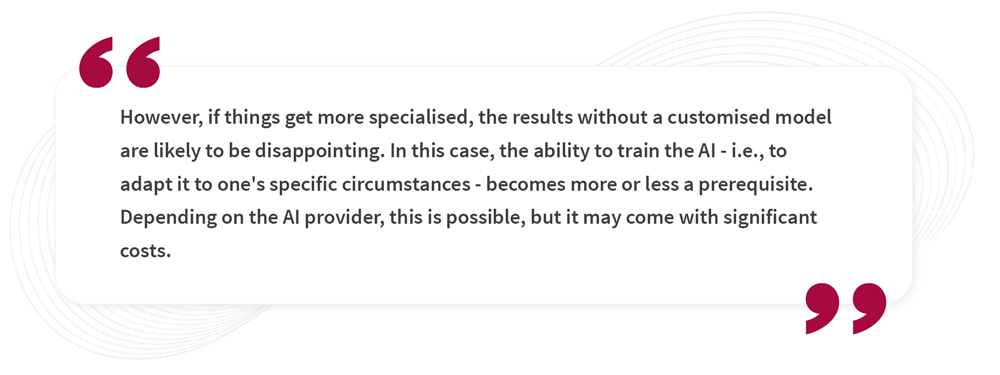Artificial intelligence in DAM systems: Wishful thinking and reality
Artificial intelligence (AI) is a hot toppic topic these days, and its potential applications in various areas are rapidly expanding. In the world of digital asset management (DAM), AI also plays an increasingly significant role. Many DAM providers already promomte AI integrations, suggesting that the use of AI can solve all the challenges of managing of digital content. However, reality is more complex. Many companies are unsure of hot to integrate AI into their DAM system or what specific benefits and risks it may entail.
In this article, we explore how AI can enhance the world of DAM, what challenges may arise and what risks particularly those related to the use of cloud-based AI functionalities, should be considered.
The potential of AI for DAM systems: more efficient, faster and smarter
1. Automated metadata generation: AI as a tagging expert
Metadata is the backbone of any DAM system, as it ensures that digital assets can be organised and found. However, manually entering high-quality metadata is time-consuming and prone to errors. AI algorithms can provide significant relief by automatically generating relevant tags and descriptions for images and videos. This is achieved through facial recognition, object recognition and text recognition.
At least, that's the impression you get when only scratching the surface of the topic.
2. Semantic search: From keyword search to context search
Traditional keyword searches in DAM systems often rely on metadata. However, even without metadata, an AI-powered semantic search can deliver relevant results by understanding the context of the query. Instead of just searching for individual keywords, the AI recognises relationships between the elements in the image and delivers more relevant results.
Example: A search query like 'woman with dog on the beach' will yield results that visually and in terms of content match this scene, even if those exact terms do not appear in the metadata.
3. Data quality and integrity: success depends on the right data
AI models are only as good as the data they are trained on. Poor data quality can lead to inaccurate metadata, misclassification and unreliable search results. It is therefore crucial that the training data is of high quality and relevant to the specific content of a company. The more specialised the content of your assets is, the less likely it is that the results of automatically generated metadata will be beneficial to you 'out of the box'.
Example: If your DAM database predominantly contains screws, it is not sufficient for the AI to simply tag all assets with 'screws' only. A distinction between wood screws, metal screws, countersunk head screws and round head screws would at least be necessary to provide added value. Depending on the AI provider, this is possible - but it may come at a significant cost.
Common AI models have been trained on hundreds of thousands or even millions of data sets - either with randomly diverse or deliberately varied assets to achieve the broadest possible content coverage. As a result, it is now easy to distinguish between a beach or a desert, a skyscraper or a tower, or a pepper and a tomato using standard models.
4. Dependence on cloud services: focusing on data protection and security
Many AI providers offer their functionalities through cloud services, which can be used by DAM providers via interfaces. However, if these AI functionalities are provided outside of a company's on-premise installation, serveral key aspects should be considered:
- Data protection and security: Files need to be transferred to the cloud in order to be analysed. This harbours security risks, especially when it comes to sensitive or copyrighted content.
- Legal issues: The use of cloud services can bring additional legal requirements and compliance challenges, particularly with regard to data protection laws such as the GDPR.
- Costs and resources: The use of cloud-based AI services typically incures costs, and implementation can be a significant financial factor - especially when use is ongoing.
Conclusion: Artificial intelligence in DAM systems - potential and caution
AI has the potential to significantly optimise DAM systems. Automated metadata generation, semantic searches and improved data quality are just a few of the benefits that AI offers. However, there are also challenges. In particular, the use of cloud-based AI functionalities raises questions about data protection, security and costs.
Careful planning, robust data protection measures and a well-founded cost-benefit analysis are essential for effectively leveraging the benefits of AI in DAM systems while minimising potential risks. This is the only way for companies to realise the full potential of AI and ensure future-proof management of their digital assets.




